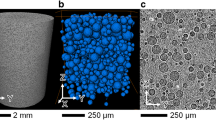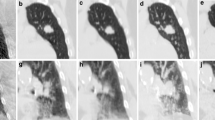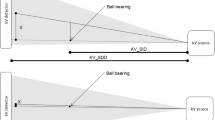Abstract
Purpose
Digitally reconstructed radiographs (DRRs) are routinely used as an a priori reference for setup correction in radiotherapy. The spatial resolution of DRRs may be improved to reduce setup error in fractionated radiotherapy treatment protocols. The influence of finer CT slice thickness reconstruction (STR) and resultant increased resolution DRRs on physician setup accuracy was prospectively evaluated.
Methods
Four head and neck patient CT-simulation images were acquired and used to create DRR cohorts by varying STRs at 0.5, 1, 2, 2.5, and 3 mm. DRRs were displaced relative to a fixed isocenter using 0–5 mm random shifts in the three cardinal axes. Physician observers reviewed DRRs of varying STRs and displacements and then aligned reference and test DRRs replicating daily KV imaging workflow. A total of 1,064 images were reviewed by four blinded physicians. Observer errors were analyzed using nonparametric statistics (Friedman’s test) to determine whether STR cohorts had detectably different displacement profiles. Post hoc bootstrap resampling was applied to evaluate potential generalizability.
Results
The observer-based trial revealed a statistically significant difference between cohort means for observer displacement vector error (\(p=0.02\)) and for \(Z\)-axis \((p<0.01)\). Bootstrap analysis suggests a 15 % gain in isocenter translational setup error with reduction of STR from 3 mm to \(\le \)2 mm, though interobserver variance was a larger feature than STR-associated measurement variance.
Conclusions
Higher resolution DRRs generated using finer CT scan STR resulted in improved observer performance at shift detection and could decrease operator-dependent geometric error. Ideally, CT STRs \(\le \)2 mm should be utilized for DRR generation in the head and neck.




Similar content being viewed by others
References
van Herk M (2004) Errors and margins in radiotherapy. Semin Radiat Oncol 14(1):52–64. doi:10.1053/j.semradonc.2003.10.003
Chen AM, Farwell DG, Luu Q, Donald PJ, Perks J, Purdy JA (2011) Evaluation of the planning target volume in the treatment of head and neck cancer with intensity-modulated radiotherapy: what is the appropriate expansion margin in the setting of daily image guidance? Int J Radiat Oncol Biol Phys 81(4):943–949. doi:10.1016/j.ijrobp.2010.07.017
Simpson DR, Lawson JD, Nath SK, Rose BS, Mundt AJ, Mell LK (2010) A survey of image-guided radiation therapy use in the United States. Cancer 116(16):3953–3960. doi:10.1002/cncr.25129
Serago CF, Buskirk SJ, Igel TC, Gale AA, Serago NE, Earle JD (2006) Comparison of daily megavoltage electronic portal imaging or kilovoltage imaging with marker seeds to ultrasound imaging or skin marks for prostate localization and treatment positioning in patients with prostate cancer. Int J Radiat Oncol Biol Phys 65(5):1585–1592. doi:10.1016/j.ijrobp.2006.04.019
Fuller CD, Scarbrough TJ, Sonke JJ, Rasch CR, Choi M, Ting JY, Wang SJ, Papanikolaou N, Rosenthal DI (2009) Method comparison of automated matching software-assisted cone-beam CT and stereoscopic kilovoltage x-ray positional verification image-guided radiation therapy for head and neck cancer: a prospective analysis. Phys Med Biol 54(24):7401–7415. doi:10.1088/0031-9155/54/24/010
Gill S, Thomas J, Fox C, Kron T, Thompson A, Chander S, Williams S, Tai KH, Duchesne G, Foroudi F (2012) Electronic portal imaging vs kilovoltage imaging in fiducial marker image-guided radiotherapy for prostate cancer: an analysis of set-up uncertainties. Br J Radiol 85(1010):176–182. doi:10.1259/bjr/13553326
Galvin JM, Sims C, Dominiak G, Cooper JS (1995) The use of digitally reconstructed radiographs for three-dimensional treatment planning and CT-simulation. Int J Radiat Oncol Biol Phys 31(4):935–942. doi:10.1016/0360-3016(94)00503-6
Kang H, Lovelock DM, Yorke ED, Kriminski S, Lee N, Amols HI (2011) Accurate positioning for head and neck cancer patients using 2D and 3D image guidance. J Appl Clin Med Phys 12(1):3270
Palombarini M, Mengoli S, Fantazzini P, Cadioli C, Degli Esposti C, Frezza GP (2012) Analysis of inter-fraction setup errors and organ motion by daily kilovoltage cone beam computed tomography in intensity modulated radiotherapy of prostate cancer. Radiat Oncol 7(1):56. doi:10.1186/1748-717X-7-56
Russo GA, Qureshi MM, Truong MT, Hirsch AE, Orlina L, Bohrs H, Clancy P, Willins J, Kachnic LA (2012) Daily orthogonal kilovoltage imaging using a gantry-mounted on-board imaging system results in a reduction in radiation therapy delivery errors. Int J Radiat Oncol Biol Phys 84(3):596–601. doi:10.1016/j.ijrobp.2012.01.033
Pallotta S, Bucciolini M (2010) A simple method to test the geometrical reliability of digital reconstructed radiograph (DRR). J Appl Clin Med Phys 11(1):3128
Cohen J (1988) Statistical power analysis for the behavioral sciences, 2nd edn. L. Erlbaum Associates, Hillsdale
Faul F, Erdfelder E, Lang AG, Buchner A (2007) G*Power 3: a flexible statistical power analysis program for the social, behavioral, and biomedical sciences. Behav Res Methods 39(2):175–191. doi:10.3758/Bf03193146
Shapiro SS, Wilk MB (1965) An analysis of variance test for normality (complete samples). Biometrika 52:591. doi:10.2307/2333709
Feustal EA, Davisson LD (1967) Asymptotic relative efficiency of mixed statistical tests. IEEE Trans Inf Theory 13(2):247. doi:10.1109/Tit.1967.1053980
Friedman M (1937) The use of ranks to avoid the assumption of normality implicit in the analysis of variance. J Am Stat Assoc 32(200):675–701. doi:10.2307/2279372
Wilcoxon F (1945) Individual comparisons by ranking methods. Biom Bull 1(6):80–83. doi:10.2307/3001968?ref=search-gateway:5782ff2ca47afd3c584def4008d48a96
Brown MB, Forsythe AB (1974) Robust tests for the equality of variances. J Am Stat Assoc 69(346):364–367. doi:10.1080/01621459.1974.10482955
Iachine I, Petersen HC, Kyvik KO (2010) Robust tests for the equality of variances for clustered data. J Stat Comput Sim 80(4):365–377. doi:10.1080/00949650802641841
Reece JE (2007) Measurement, analysis, and control using JMP: quality techniques for manufacturing. SAS Press, SAS Institute, Cary
Sharma SD, Dongre P, Mhatre V, Heigrujam M (2012) Evaluation of automated image registration algorithm for image-guided radiotherapy (IGRT). Australas Phys Eng Sci Med 35(3):311–319. doi:10.1007/s13246-012-0158-9
Yang J, Garden AS, Zhang Y, Zhang L, Dong L (2012) Variable planning margin approach to account for locoregional variations in setup uncertainties. Med Phys 39(8):5136–5144. doi:10.1118/1.4737891
van Kranen S, van Beek S, Rasch C, van Herk M, Sonke JJ (2009) Setup uncertainties of anatomical sub-regions in head-and-neck cancer patients after offline CBCT guidance. Int J Radiat Oncol Biol Phys 73(5):1566–1573. doi:10.1016/j.ijrobp.2008.11.035
Acknowledgments
This work was supported in part by National Institutes of Health Cancer Center Support (Core) Grant CA016672 to The University of Texas MD Anderson Cancer Center. Clifton Fuller received/receives Grant support from the SWOG/Hope Foundation Dr. Charles A. Coltman, Jr., Fellowship in Clinical Trials, the National Institutes of Health Paul Calabresi Clinical Oncology Award ( 5K12 CA088084-14) and Clinician Scientist Loan Repayment Program (L30 CA136381-02), Elekta AB (Stockholm, SE), the Center for Radiation Oncology Research at MD Anderson Cancer Center, and the MD Anderson Institutional Research Grant Program. These listed funders/supporters played no role in the study design, collection, analysis, interpretation of data, manuscript writing, or decision to submit the report for publication.
Conflict of interest
Jared D. Sturgeon, John A. Cox, Lauren L. Mayo, G. Brandon Gunn, Lifei Zhang, Peter A. Balter, Lei Dong, Musaddiq Awan, Esengul Kocak-Uzel, Abdallah Sherif Radwan Mohamed, David I. Rosenthal, and Clifton David Fuller declare that they have no conflict of interest.
Author information
Authors and Affiliations
Corresponding author
Electronic supplementary material
Below is the link to the electronic supplementary material.
Rights and permissions
About this article
Cite this article
Sturgeon, J.D., Cox, J.A., Mayo, L.L. et al. Improved human observer performance in digital reconstructed radiograph verification in head and neck cancer radiotherapy. Int J CARS 10, 1667–1673 (2015). https://doi.org/10.1007/s11548-014-1127-4
Received:
Accepted:
Published:
Issue Date:
DOI: https://doi.org/10.1007/s11548-014-1127-4




